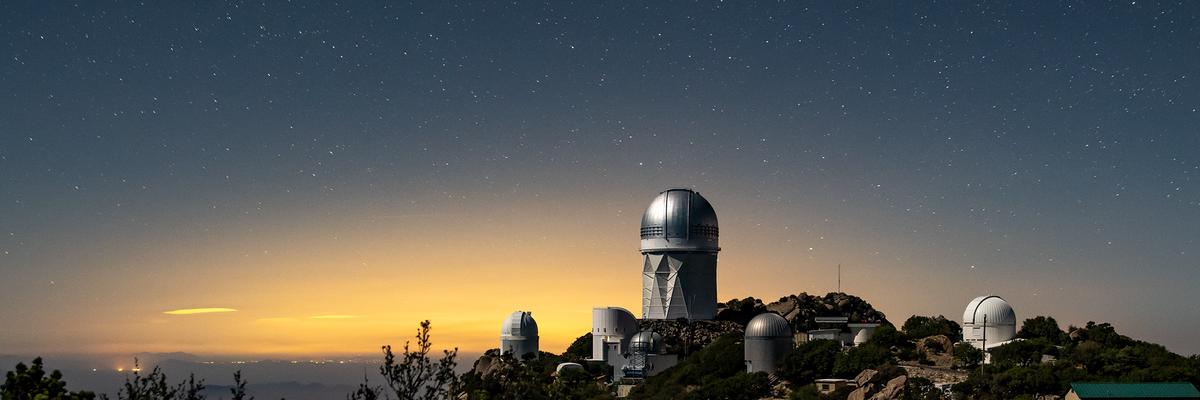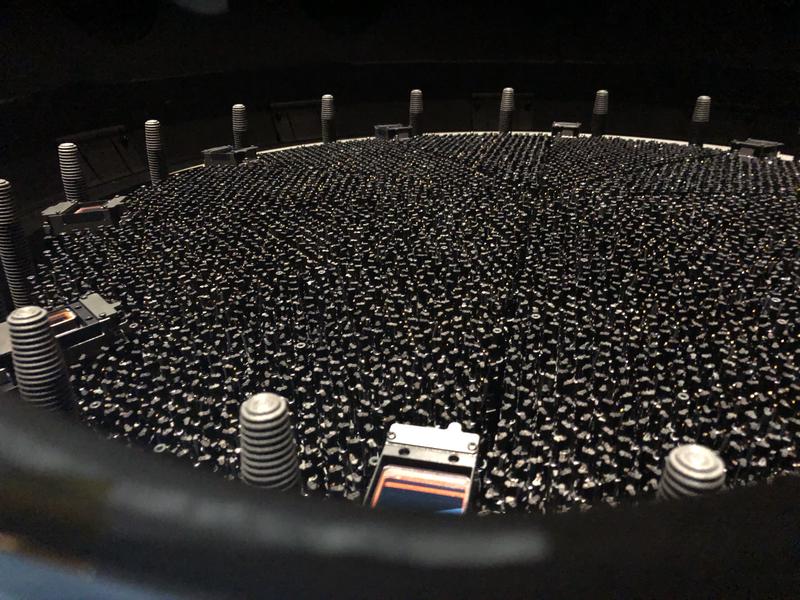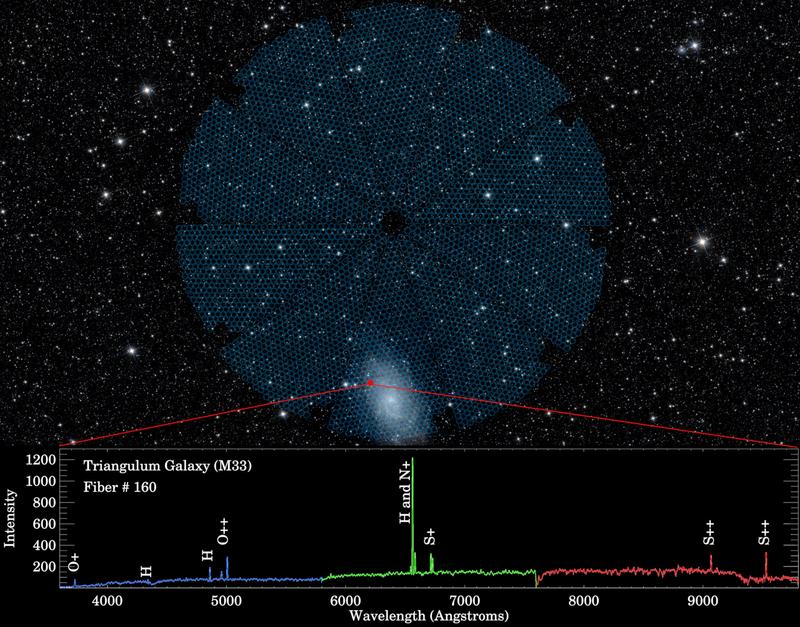Highlight
DESI Opens Its 5,000 Eyes to Capture the Colors of the Cosmos
October 28, 2019
- The Dark Energy Spectroscopic Instrument (DESI), a new instrument designed to accurately map the Universe, begins its final testing stage.
- Researchers from the Institut de Física d’Altes Energies (IFAE), the Institute of Space Science (ICE, CSIC), the Institute of Space Studies of Catalonia (IEEC), the Centro de Investigaciones Energéticas, Medioambientales y Tecnológicas (CIEMAT) and the Instituto de Física Teórica (IFT, UAM-CSIC) participate in the project.

A new instrument installed on a telescope in Arizona (USA) that will observe a record number of galaxies and quasars, made its first light observation by pointing its 5000 fiber-optic “eyes” towards the cosmos during the night of 22 to 23 October, to test its unique view of the Universe.
The instrument is called the Dark Energy Spectroscopic Instrument, known as DESI, and its installation is about to be completed. The instrument is designed to explore the mystery of dark energy, which makes up approximately 68% of the Universe and is responsible for its accelerated expansion. To achieve this, DESI will observe a third of the sky for 5 years with the aim of mapping the distance between the Earth and 35 million galaxies, plus another 2.4 million quasars. The instrument will start scientific observations in early 2020.
The most detailed three-dimensional map of the Universe
Resembling a powerful time machine, DESI will investigate the Universe in its early infancy and early evolution (about 11 billion years ago) to create the most detailed three-dimensional map of the Universe to date.
DESI will also provide very accurate measurements of the Universe’s rate of expansion and how it has varied over time. Gravity slowed this expansion in the early Universe but, ever since, the action of dark energy has been responsible for accelerating its expansion.
“After a decade in planning and Research & Development, installation and assembly, we are delighted that DESI can soon begin its quest to unravel the mystery of dark energy,” says DESI Director Michael Levi of the Department of Energy’s Lawrence Berkeley National Laboratory (Berkeley Lab), the U.S. institution that leads DESI’s construction and operations.
“Uncovering the mystery of dark matter and dark energy represents a challenge for understanding how the Universe behaves. State-of-the-art experiments like DESI are the best way forward to solve these riddles,” adds Ramon Miquel, the project’s principal investigator at IFAE.
DESI is designed to automatically target pre-selected clusters of galaxies and collect their light to then scatter it into narrow bands of color. This will make it possible to determine with great precision the speed at which galaxies move away from us, to know their distance from Earth and to measure how much the Universe expanded as this light traveled to us. Ideally, DESI can measure a new set of 5000 galaxies every 20 minutes.
5000 robotic fiber-optic “eyes”
The DESI collaboration involves about 500 researchers from 75 institutions in 13 countries. In the last 18 months, the components of the instrument were sent from these institutions around the world to the Nicholas U. Mayall Telescope, located at the Kitt Peak National Observatory in Tucson (Arizona, USA), where they have been installed.
The instrument’s primary mirror, 4 metres in diameter, and the set of corrective lenses, each about one metre in diameter, provide DESI with a large field of vision. The focal plane of the instrument is composed of 10 wedge-shaped petals, each containing 500 robotic positioners and a small camera that allows the telescope to be focused, aligned and pointed to optimally collect light from galaxies. The small positioning robots, which hold each of the optical fibers that collect the light, serve as the eyes of DESI.

DESI is able, in just 10 seconds, to automatically reposition all the optical fibers and focus on a new set of galaxies. Thanks to this speed, it will be able to map more than 20 times more cosmic objects than any previous instrument.
“DESI will not only contribute to substantially improving our understanding of dark energy, but it will also mean new knowledge about neutrinos, the most elusive particles known, since it is capable to measure their influence on the evolution of the Universe”, explains Eusebio Sánchez, DESI’s principal researcher at CIEMAT.
Among the last components installed is the set of spectrographs designed to divide the collected light into three separate colour bands and, thus, allow precise measurements of the distance of the observed galaxies. These spectrographs, which allow DESI’s robotic eyes to “see” even distant and faint galaxies, are designed to measure the redshift, which is a change in the color of cosmic objects to longer and redder wavelengths as they move away from us.
“Being able to simultaneously observe so many galaxies and measure their distance by obtaining their spectrum has required technological development to produce such a high-precision instrument,” adds Francisco Castander, as principal investigator of ICE-CSIC and IEEC.

Contribution of the Barcelona-Madrid group to the DESI project
The instrumental contribution to DESI of the Barcelona-Madrid Regional Participation Group, made up of researchers from IFAE, ICE-CSIC, IEEC, CIEMAT and IFT-UAM, has consisted of the design, construction and installation of the complete Guiding, Focusing and Alignment system (GFA). This system is made up of 10 cameras, each of them installed in one of the focal plane petals of the instrument which, as its name indicates, are in charge of focusing, guiding and aligning the telescope so that the robotic positioners can collect the light from the galaxies under optimum conditions. This contribution has been led by IFAE, where the construction of the cameras has been carried out, with the collaboration of ICE, IEEC, CIEMAT and IFT. In addition, ICE and IEEC have led the production of the software to be able to point the whole instrument properly.
“The production of the self-guided cameras has required a great effort from all our team, as we had to overcome many technological challenges under very tight deadlines”, points out Laia Cardiel-Sas, from IFAE and coordinator of the engineering team. “Our team is very satisfied with the performance of our cameras installed on the instrument,” adds IFAE engineer Otger Ballester.
“It is a huge satisfaction to be able to point a telescope that weighs 260 tons with a precision of microns, with our cameras and the software we have developed”, concludes Santiago Serrano, ICE-CSIC and IEEC engineer. “After several years of working within the big family of the DESI collaboration, we are excited to see the first successful tests of the instrument and are looking forward to the scientific results that will come after starting operations,” says Ricard Casas, also a researcher at ICE-CSIC and IEEC.
More information
DESI is funded by the following institutions: the Office of Science of the U.S. Department of Energy; the U.S. National Science Foundation; the Division of Astronomical Sciences under contract to the National Observatory of Optical Astronomy; the UK Council for Scientific and Technological Facilities; the Gordon and Betty Moore Foundation; the Heising-Simons Foundation; the French Commission for Alternative Energy and Atomic Energy (CEA); the National Council for Science and Technology of Mexico; the Ministry of Science, Innovation and Universities of Spain; and DESI member institutions. DESI scientists are honored to be allowed to conduct astronomical research at lolkam Du’a (Kitt Peak, Arizona), a mountain of particular significance to the Tohono O’odham nation.
The Centro de Investigaciones Energéticas, Medioambientales y Tecnológicas (CIEMAT), the Institute of Space Science (ICE-CSIC), the Institute of Space Studies of Catalonia (IEEC), the Institut de Física d’Altes Energies (IFAE) and the Instituto de Física Teórica (UAM-CSIC) participate in DESI through the Barcelona-Madrid RPG. The Instituto Astrofísica Andalucía (IAA), the Instituto de Astrofísica de Canarias (IAC) and the Instituto de Física Teórica (UAM-CSIC) participate in DESI through the Granada-Madrid-Tenerife RPG. Researchers from the Institute of Cosmos Sciences of the Universitat de Barcelona (ICCUB) also participate in the DESI project.
The full list of institutions participants and more information about DESI is available at the following link: https://www.desi.lbl.gov .
- IFAE Research group
- Observational Cosmology Group
- Contact
